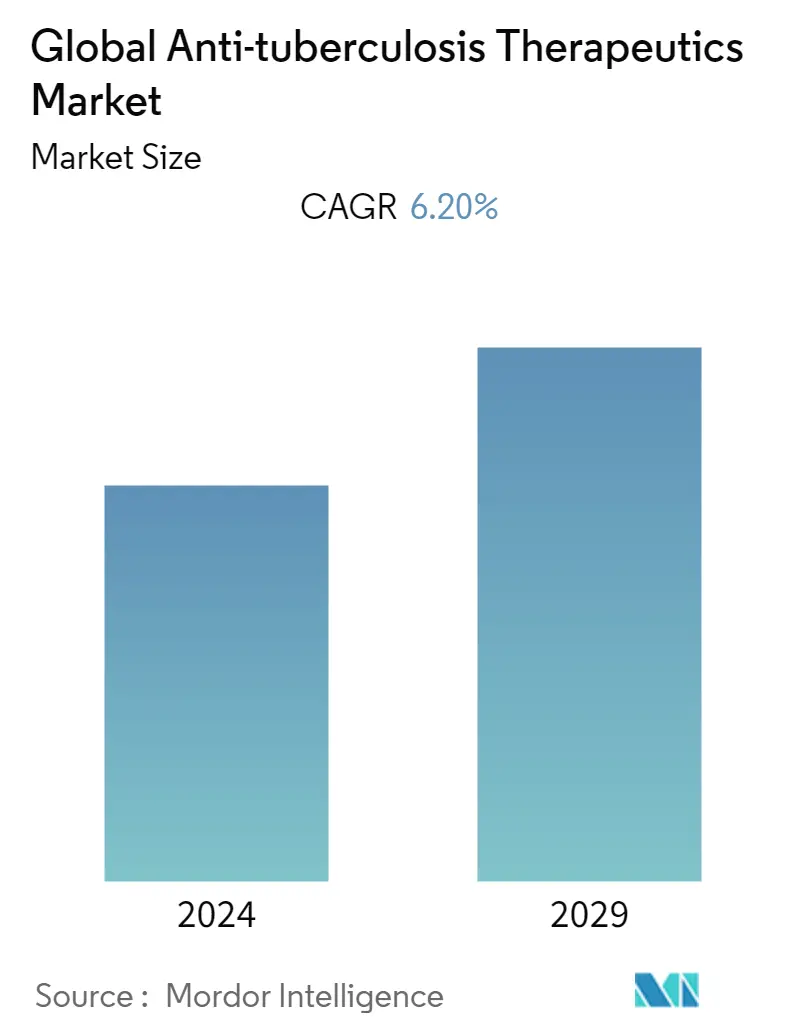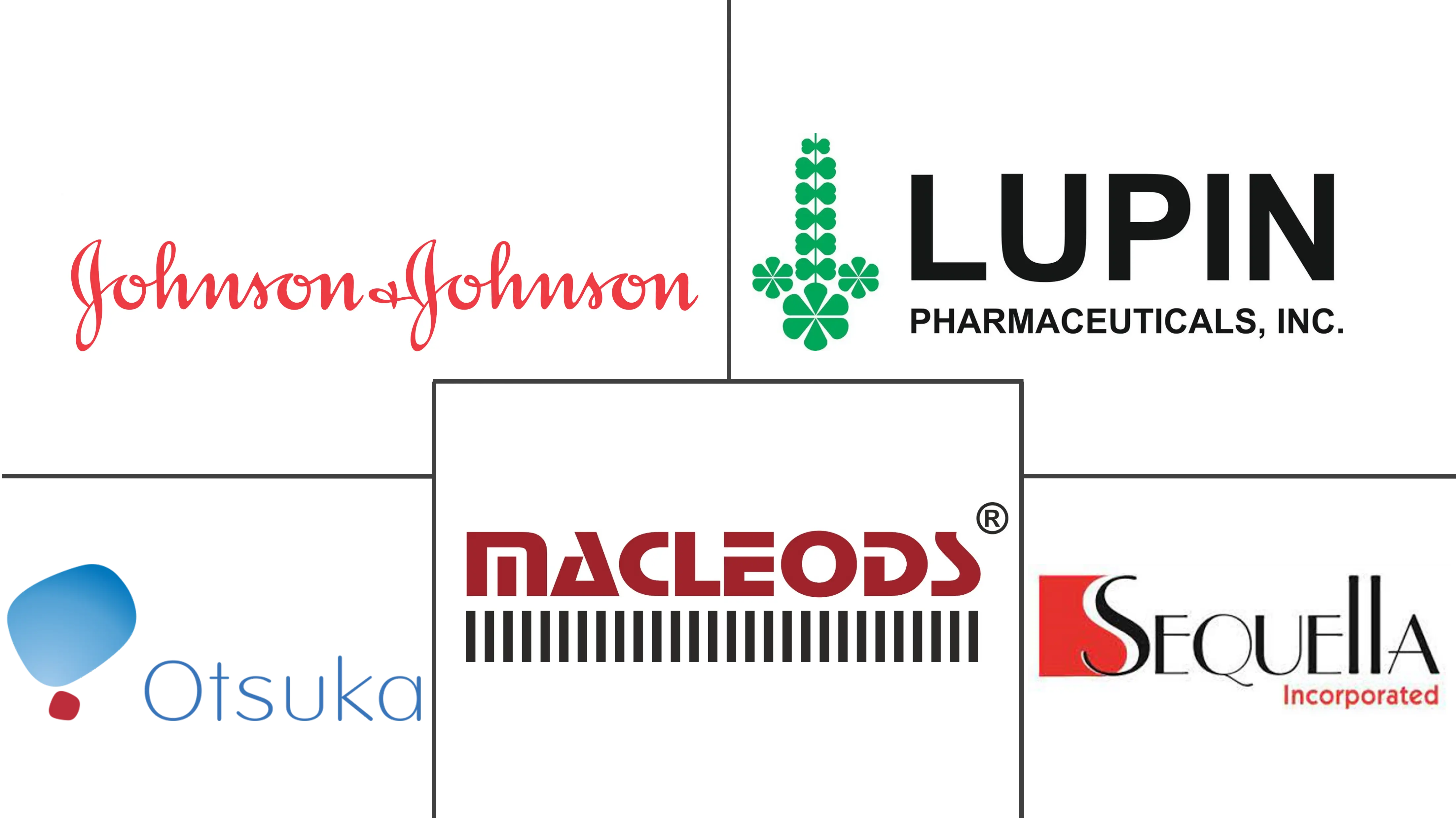Market Size of Global Anti-tuberculosis Therapeutics Industry

| Study Period | 2019 - 2029 |
| Base Year For Estimation | 2023 |
| Forecast Data Period | 2024 - 2029 |
| CAGR | 6.20 % |
| Fastest Growing Market | Asia Pacific |
| Largest Market | North America |
Major Players
*Disclaimer: Major Players sorted in no particular order |
Anti-tuberculosis Therapeutics Market Analysis
The Anti-tuberculosis (TB) Therapeutics Market is expected to witness a CAGR of 6.2% during the forecast period (2022 - 2027).
The COVID-19 pandemic had a significant impact on the healthcare systems, with significant consequences not only for COVID-19-infected patients but also for others, resulting in the cancellation of diagnosis and treatment services to manage and reserve resources, and many hospitals are experiencing a shortage of professionals to assist with these diagnostic and treatment procedures. The COVID-19 restrictions imposed by the government have impacted the market growth. For instance, according to the data published by the World Health Organization, in March 2021, titled 'Impact of the COVID-19 pandemic on TB detection and mortality in 2020', it has been observed that an estimated 1.4 million fewer persons underwent TB treatment in 2020 than in 2019, a 21% decrease from 2019. Additionally, as per an article published by the International Journal of Tuberculosis and Lung Disease, in June 2021, titled 'The impact of COVID-19 on TB: a review of the data, it has been observed that the provision of tuberculosis services has been hampered with high TB burden due to inadequate capacity and equipment, restrictions on migration (affecting health care staff, supplies, and stock), and resource reallocation. Also, tuberculosis patients have struggled to get TB services, either due to fear of SARS-CoV-2 infection, fear of stigma, mobility restrictions, shortened health facility operating hours, or reduced financial resources to pay for care or transportation. As a result, TB diagnosis, treatment, and prevention have been impacted globally. Thus, COVID-19 has significantly impacted the market growth during the pandemic.
Certain factors that are propelling the market growth are the rising prevalence of tuberculosis, a growing initiative from government organizations for tuberculosis awareness, and the rising incidence of multi-drug resistant (MDR) and extensively drug-resistant tuberculosis (XDR) cases in developing countries.
The COVID-19 pandemic had a significant impact on the healthcare systems, with significant consequences not only for COVID-19-infected patients but also for others, resulting in the cancellation of diagnosis and treatment services to manage and reserve resources, and many hospitals are experiencing a shortage of professionals to assist with these diagnostic and treatment procedures. The COVID-19 restrictions imposed by the government have impacted the market growth. For instance, according to the data published by the World Health Organization, in March 2021, titled 'Impact of the COVID-19 pandemic on TB detection and mortality in 2020', it has been observed that an estimated 1.4 million fewer persons underwent TB treatment in 2020 than in 2019, a 21% decrease from 2019. Additionally, as per an article published by the International Journal of Tuberculosis and Lung Disease, in June 2021, titled 'The impact of COVID-19 on TB: a review of the d, it has been observed that the provision of tuberculosis services has been hampered with high TB burden due to inadequate capacity and equipment, restrictions on migration (affecting health care staff, supplies, and stock), and resource reallocation. Also, tuberculosis patients have struggled to get TB services, either due to fear of SARS-CoV-2 infection, fear of stigma, mobility restrictions, shortened health facility operating hours, or reduced financial resources to pay for care or transportation. As a result, TB diagnosis, treatment, and prevention have been impacted globally. Thus, COVID-19 has negatively impacted the market growth during the pandemic.
Additionally, the rising incidence of multi-drug resistant tuberculosis (MDR-TB) and XDR in developing countries is also expected to boost market growth over the forecast period. For instance, according to an article published by the Journal of Family Medicine and Primary Care, in January 2022, titled 'Status of drug-resistant tuberculosis among patients attending a tuberculosis unit of West Bengal', it has been observed that the prevalence of tuberculosis and multidrug-resistant tuberculosis (MDR-TB) is highest in India and ranks first in the global ranking of detecting new cases each year. In addition, as per the same source, an estimated overall incidence of tuberculosis in India was 193 per lakh people, in 2020.
Furthermore, the growing government initiatives in creating awareness among the population regarding tuberculosis (TB) are also expected to propel market growth over the forecast period. For instance, in March 2021, Dr. Harsh Vardhan, Union Minister for Health and Family Welfare launched the 'Tribal TB Initiative' along with Shri Arjun Munda, Union Minister for Tribal Affairs in the presence of Shri Ashwini Kumar Choubey, Minister of State for Health and Family Welfare in India. Also, in July 2019, the State Council of China released the Healthy China Initiative 2019-2030, which included 15 special campaigns, including the Tuberculosis Control Action to guide the way for China's TB prevention and control. Hnece, these factors are expected to boost the market growth.
However, the adverse side effects of anti-tuberculosis drugs and the high cost of MDR and XDR TB drugs are likely to impede the market growth over the forecast period.
Anti-tuberculosis Therapeutics Industry Segmentation
As per the scope of the report, Tuberculosis (TB) is a disease affecting the population across the world. Although tuberculosis is a curable disease, it remains one of the most common causes of death among adults, particularly in emerging economies. The Anti-tuberculosis Therapeutics Market is segmented by Drug Class (Isoniazid, Rifampin, Ethambutol, Pyrazinamide, Fluoroquinolones, Bedaquiline, Aminoglycosides, Thioamides, Cyclic Peptides, and Other Drug Classes), End User (Hospitals and Clinics, Government Agencies, Non-Profit Organizations, and Other End Users), and Geography (North America, Europe, Asia-Pacific, Middle East, and Africa, and South America. The market report also covers the estimated market sizes and trends for 17 different countries across major regions globally. The report offers the value (in USD million) for the above segments.
| By Drug Class | |
| Isoniazid | |
| Rifampin | |
| Ethambutol | |
| Pyrazinamide | |
| Fluoroquinolones | |
| Bedaquiline | |
| Amynoglycosides | |
| Thioamides | |
| Cyclic Peptides | |
| Other Drug Classes |
| By End User | |
| Hospitals and Clinics | |
| Government Agencies | |
| Non Profit Organizations | |
| Other End Users |
| Geography | ||||||||
| ||||||||
| ||||||||
| ||||||||
| ||||||||
|
Global Anti-tuberculosis Therapeutics Market Size Summary
The anti-tuberculosis therapeutics market is poised for growth, driven by the increasing prevalence of tuberculosis and the rising incidence of multi-drug resistant and extensively drug-resistant cases, particularly in developing countries. Government initiatives aimed at raising awareness and improving TB control measures are also contributing to market expansion. However, the market faced challenges during the COVID-19 pandemic, which disrupted TB diagnosis and treatment services due to resource reallocation and healthcare system strains. Despite these setbacks, the market is expected to recover and grow, supported by the ongoing development and adoption of effective therapeutics, such as isoniazid, which is gaining traction due to its efficacy in treating TB strains with specific mutations.
North America is anticipated to lead the market, bolstered by a well-established healthcare infrastructure and significant healthcare spending, which facilitates the development of novel TB drugs. The region's increasing TB cases underscore the demand for effective therapeutics, driving market growth. The market is characterized by a high level of consolidation, with a few major companies holding substantial shares. However, the focus on research and development is expected to attract more small to mid-sized companies, fostering competition and innovation. Collaborative efforts, such as those by Johnson & Johnson and TB Alliance, highlight the industry's commitment to addressing the global TB burden through strategic partnerships and licensing agreements.
Global Anti-tuberculosis Therapeutics Market Size - Table of Contents
-
1. MARKET DYNAMICS
-
1.1 Market Overview
-
1.2 Market Drivers
-
1.2.1 Rising Prevalence of Tuberculosis
-
1.2.2 Growing Initiative from Government Organization for Tuberculosis Awareness
-
1.2.3 Rising Incidence of MDR and XDR Cases in Developing Countries
-
-
1.3 Market Restraints
-
1.3.1 Adverse Side Effects of Anti-tuberculosis Drugs
-
1.3.2 High Cost of MDR and XDR TB Drugs
-
-
1.4 Porter's Five Force Analysis
-
1.4.1 Threat of New Entrants
-
1.4.2 Bargaining Power of Buyers/Consumers
-
1.4.3 Bargaining Power of Suppliers
-
1.4.4 Threat of Substitute Products
-
1.4.5 Intensity of Competitive Rivalry
-
-
-
2. MARKET SEGMENTATION (Market Size by Value - USD million)
-
2.1 By Drug Class
-
2.1.1 Isoniazid
-
2.1.2 Rifampin
-
2.1.3 Ethambutol
-
2.1.4 Pyrazinamide
-
2.1.5 Fluoroquinolones
-
2.1.6 Bedaquiline
-
2.1.7 Amynoglycosides
-
2.1.8 Thioamides
-
2.1.9 Cyclic Peptides
-
2.1.10 Other Drug Classes
-
-
2.2 By End User
-
2.2.1 Hospitals and Clinics
-
2.2.2 Government Agencies
-
2.2.3 Non Profit Organizations
-
2.2.4 Other End Users
-
-
2.3 Geography
-
2.3.1 North America
-
2.3.1.1 United States
-
2.3.1.2 Canada
-
2.3.1.3 Mexico
-
-
2.3.2 Europe
-
2.3.2.1 Germany
-
2.3.2.2 United Kingdom
-
2.3.2.3 France
-
2.3.2.4 Italy
-
2.3.2.5 Spain
-
2.3.2.6 Rest of Europe
-
-
2.3.3 Asia-Pacific
-
2.3.3.1 China
-
2.3.3.2 Japan
-
2.3.3.3 India
-
2.3.3.4 Australia
-
2.3.3.5 South Korea
-
2.3.3.6 Rest of Asia-Pacific
-
-
2.3.4 Middle East and Africa
-
2.3.4.1 GCC
-
2.3.4.2 South Africa
-
2.3.4.3 Rest of Middle East and Africa
-
-
2.3.5 South America
-
2.3.5.1 Brazil
-
2.3.5.2 Argentina
-
2.3.5.3 Rest of South America
-
-
-
Global Anti-tuberculosis Therapeutics Market Size FAQs
What is the current Global Anti-tuberculosis Therapeutics Market size?
The Global Anti-tuberculosis Therapeutics Market is projected to register a CAGR of 6.20% during the forecast period (2024-2029)
Who are the key players in Global Anti-tuberculosis Therapeutics Market?
Macleods Pharmaceuticals Ltd, Otsuka Pharmaceutical Co. Ltd, Johnson and Johnson, Sequella, Inc. and Lupin Limited are the major companies operating in the Global Anti-tuberculosis Therapeutics Market.

